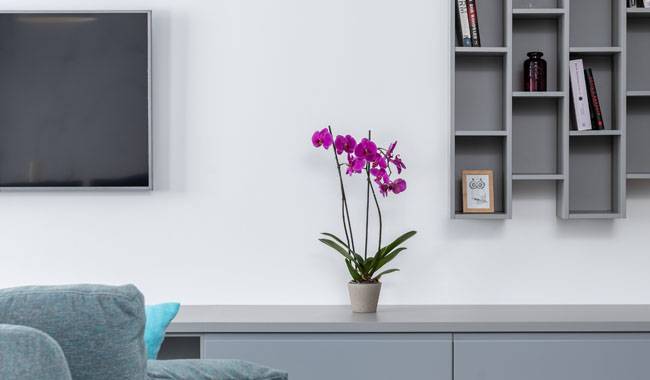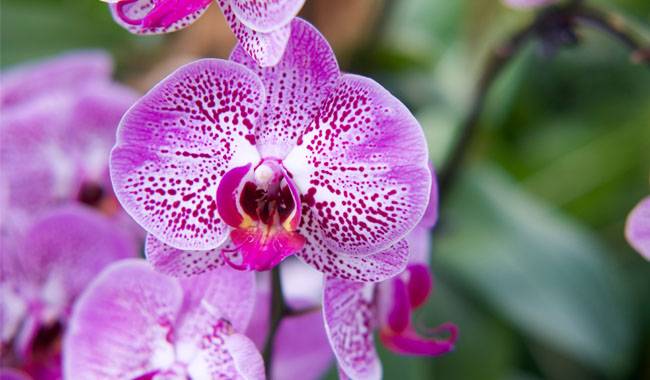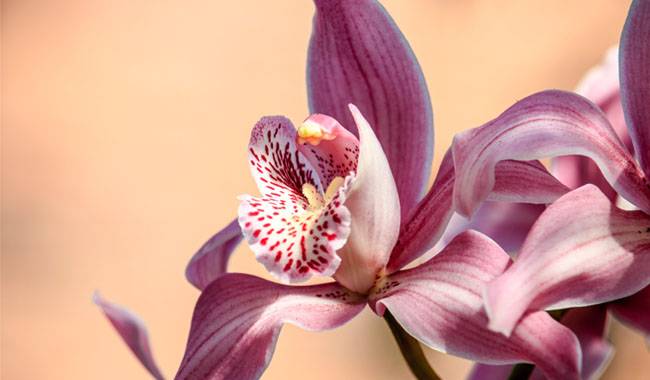
Today, when you look at the splendor of orchids blooming on a shelf, it is hard to believe that just a few decades ago, these exquisite plants could only be grown in dreams as houseplants. Hybrid plants are becoming more and more common and are doing very well in room form. And, if desired, even the most demanding species can be easily found. However, choosing orchids for your home is not getting any easier, and the choice should still not be made lightly. Orchids are special in every way. And if you don’t want to be disappointed, you should try to weigh up the pros and cons and find the perfect plant for you. You will learn how to grow orchid plants in ThumbGarden’s article.
A FLOWER WITH LOVE IN ITS HEART – ORCHIDS
Orchids often come into the home as gifts, as a surprise from a loved one, or as a result of spontaneous purchases tempted by their beauty or percentage discounts. However, when orchids are deliberately purchased, it is not just a matter of heart and taste. Instead, it is best not to succumb to the temptation of these special plants and not to judge their quality as ornamental plants until all practical issues (condition, care, stage of development) have been taken into account and the chances of success have been sensibly calculated.
The conditions of the house and potential site should first be analyzed and objectively assessed. It is only worth finding a ‘place’ for a plant if it is a gift, not the other way round. Existing conditions, particularly the ability to provide cool housing and control air humidity, already limit your choices to only a few species.
If you want a reliable, frugal choice, it is best to forgo buying ‘difficult’ species and opt for plants that will perform well in any living room.
The rule of thumb that any ‘mass market’ orchid can be accepted as suitable for home growing couldn’t be further from the truth. If you are not an experienced collector, you will do well to look at the variety and beauty of orchids in supermarkets, big box stores, and specialist florists. The ones you see on the shelves are the plainest of the plain. You don’t need to buy orchids there either, as you can look for varieties and colors elsewhere.
BEST ORCHID VARIETIES FOR INDOORS
It is not at all difficult to identify the best group of orchids for a room form. These are unpretentious, hardy orchid hybrids that adapt well to ‘flat’ light and humidity and whose names have become easily recognizable (and often protected) trademarks. They are available in hundreds of varieties on the market.
Phalaenopsis is the most popular and ‘reliable’ single epiphytic Phalaenopsis, with long, elegantly shaped flowers and beautiful large black leaves. It flowers several times on a single stem, is content in any bright warm spot and with minimal care, and forgives lapses. There are dwarf, medium, and large varieties to suit any taste.
Cattleya is large-flowered, often with single but very showy fragrant flowers, single or double-leaved Symphytum orchids with showy pseudobulbs. They are very fond of diurnal contrasts and bright light but are pretty happy with medium humidity.
Paphiopedilum is a single hardy orchid with a neat double-sided rosette of mostly spotted leaves, flowering stems growing directly from the center, and watery petals with huge sails and lips. The flowering of these epiphytes is stimulated by cool nights but is generally very easy to care for. They tolerate dry air well but are very demanding of soil moisture.
Ludisia is known for its raised shoots and oval often patterned leaves and its fragrant, delicate flowers in delicate, upright bouquets that remind many people of night violets. Ludisia blooms in winter. It is planted in a similar way to cacti and does not like small containers.
Coelogyne is an epiphytic symbiotic white-yellow beauty with elegant spikes. The oval, double-leaved pseudobulbs and elegant crown-shaped flowers – a reward for cool overwintering and moderate care.
Dendrobium is attractive, large hybrids with pseudobulbs, straight, sword-shaped leaves, and majestic-looking, luxurious flower clusters with ‘eyes’ and pointy petals. They have a distinct dormancy period, and the varieties have different temperature requirements but are still ‘common’ indoor orchids.
Other room-adapted orchids will be happy with regular care.
Cambria;
Pleione;
Cymbidium;
Vanda;
Oncidium;
Complex hybrids of Leliocattleya, Brassocattleya, Potinara, Colmanara, Miltonidium, Odontocidium, Vuelstekeara, etc.
WHERE TO BUY ORCHIDS FOR YOUR HOME?

There are many options for large flower and garden centres, popular websites, local florists, greenhouses, collectors, and specialist clubs for deliveries. Of course, choosing a plant in person is always more reliable than following photos and descriptions. But in any case, if you are careful, you can buy healthy orchids.
As well as assessing the condition of the orchid, you should pay particular attention to the quality of the delivery and packaging, the reputation, and the seller’s guarantee. There is also the “freshness” of the plants, the length of time they have been in the sales area (ideally no more than 2 to 3 weeks after delivery).
Starting information for orchids
When buying an orchid for your home, the most important thing is knowledge. Orchids are unique plants. Each of the more than 30,000 orchids has something unique to offer, not just in terms of color and flower shape. Even species with the same trade name can have different characteristics and habits. And, rather than face surprises later, don’t be too coy about asking around and looking for information.
It is almost impossible to give your proper orchid care while remaining a stranger. The opposite is also true: if you know exactly which orchid you are dealing with, it is easy to find information about all the nuances of growing it, even if there is no advice at the time of purchase.
Important tips when buying and choosing an orchid are as follows
- The exact name of the orchid chosen
- The origin of the orchid – the conditions to which it is adapted (warm, moderately warm, moderately cold, and cold orchids require different efforts and attention)
- The significant dormancy period, the cyclical development, and the need to change conditions at different stages.
- Whether the orchid is terrestrial or epiphytic (whether it can be grown in pots only or also on stumps and blocks of wood)
- Whether the orchid is symbiotic (easily identified by rhizomes and pseudobulbs, growing in groups with new seasonal growth on top of the old) or monoecious (has a main stem that does not produce branches, growing upwards by producing new leaves with peduncles and aerial roots between the leaves).
- Whether the orchid is defoliated, whether the stem is wilted and how it develops.
- What the roots, pseudobulbs, leaves, peduncles, and flowers should ideally look like.
- What is the average flowering period and when orchids are ‘used’ to flowering.
- How flower stems develop and what factors affect flowering.

EXTERNAL HEALTH AND CONDITION ASSESSMENT
The external signs of an orchid are a good or bad guide to its health. Inspect an orchid carefully – from roots to flowers – without leaving any ‘part’ untouched before buying. It is easier to assess an orchid in flower; only have enough experience to take a chance on an orchid without a flowering stem. The more experience you have in rescuing orchids, the greater the risk. However, it is best to start by choosing only strong, mature, and flowering plants.
The above-ground parts of an orchid are simple: thick, dense leaves and flowering stems of even, rich color indicate that everything is in good order. Only slight imperfections are allowed. Anything ‘contrary’ – large black spots, suspicious damage, shriveling, deformation, dullness, uneven color, or even more so, signs of camouflaged pruning of the leaves – is reason to reject a purchase. Younger pseudobulbs are of dubious size compared to older ones, or they are too numerous, suggesting that the orchid has been on the market for several seasons.
The condition of the roots is often more difficult to assess. It is best to choose an orchid in a clear container where the roots and substrate are easily visible (this is how well-known flower centers sell orchids). However, if the container is different, it is still necessary to check at least the upper layer and the aerial roots, without forgetting the soil. A healthy, strong root system is immediately visible. Whether whitish or yellowish, depending on the variety, young or old, the roots of an orchid should be firm and without any signs of dryness or severe deformation, injury, or spotting. Orchids with any signs of root rot or softening should be avoided.
The substrate should be checked by smell and touch as signs of mould and acidification, rotten bark, salt deposits, and suspicious impurities should be easy to identify. You will also need to check the planting to ensure that the orchids are sitting upright and that they do not wobble if you touch them in any way.
Dear ThumbGarden’s readers
Whatever orchid you want to keep in your home, remember that the real adventure begins when you buy it. So even the strongest, healthiest plant can enjoy many years. It needs to be transported correctly, quarantined, and given the right conditions to adapt to its new home – preferably with a few months of greenhouse growth. Transplanting should not take place until it is needed.







